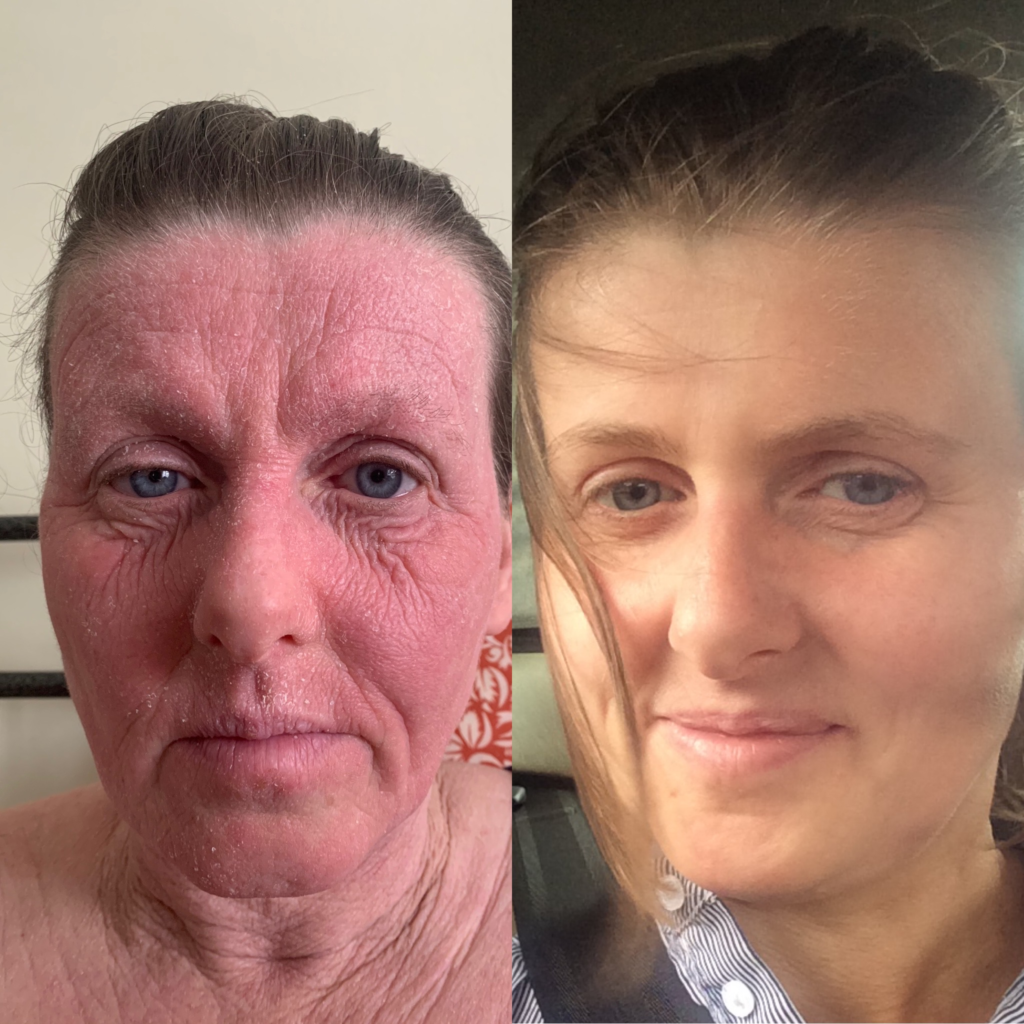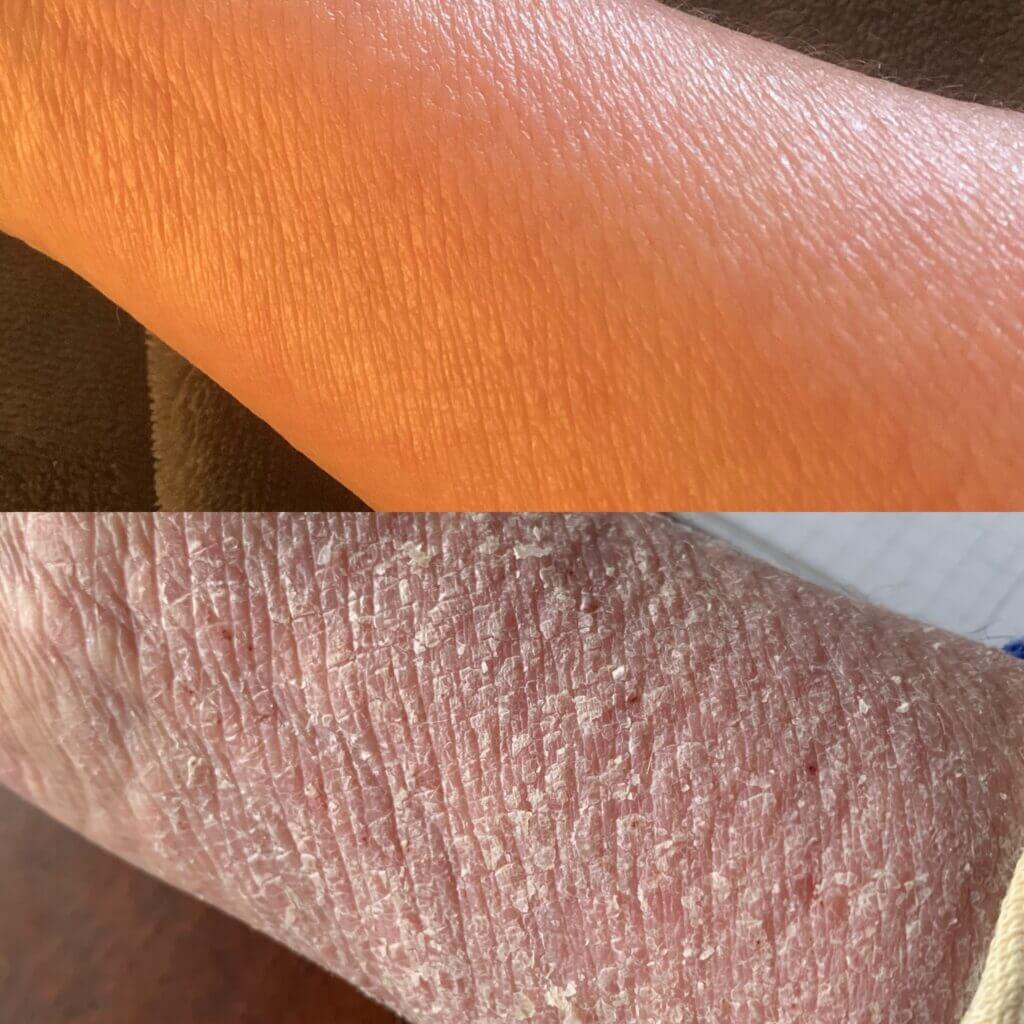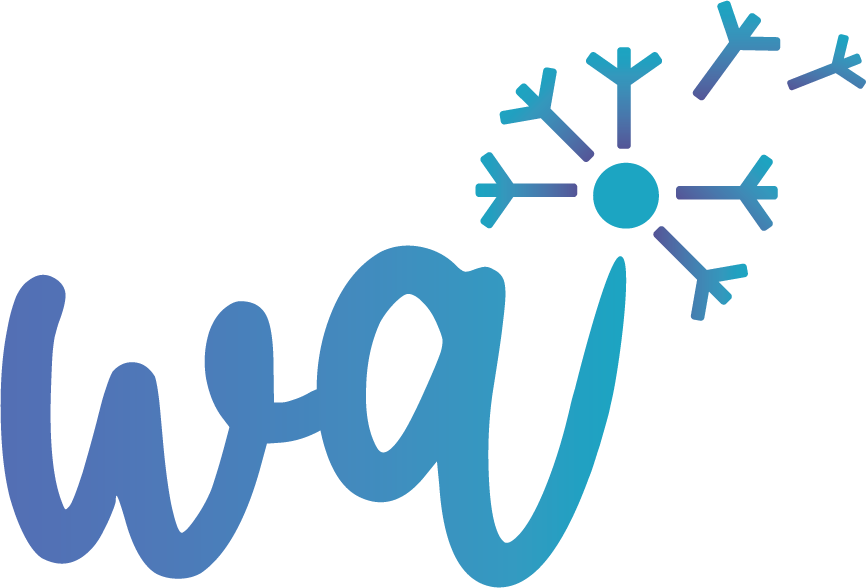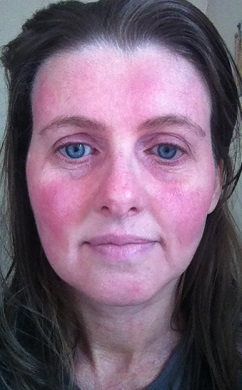This has been a long, long time coming but finally, all of us who reported our Topical Steroid Withdrawal (TSW) through the Yellow Card scheme can feel some relief that TSW is finally being taken seriously.
A press release was released today, 15th September, during National Eczema Awareness Week to finally recognise that TSW is a thing!
MHRA advises clinicians to be vigilant of topical steroid withdrawal symptoms
This wasn’t widely publicised though and I feel it has most definitely been slipped under the door without much fanfair of publicity.
The gaslighting…
For so long our GPs, doctors and dermatologists have been ignoring us, telling us:
- we’re wrong,
- we’re just steroid phobic
- we used the drugs wrongly
- we just need to use more
I honestly don’t know how any doctor or dermatologist can look a patient with the signs of TSW and feel like they are doing the best for them.
My eczema was never ever as bad is the picture on the left. And it’s been worse that this in TSW but I’ve not managed to get pictures well as I live on my own, and when it’s really bad the last thing you want to do is take pictures.
I knew I had a problem when just days without my daily topical medication saw my skin deteriorate so fast and so badly that it would be oozing open wounds. This is not eczema. This is topical steroid withdrawal.

Here’s that press release in full:
Long-term continual use of topical steroids linked to skin withdrawal side effects
Patients using topical corticosteroid creams to treat conditions such as eczema or psoriasis are reminded to do so in accordance with advice from their healthcare professional, after a national review found that people using topical steroid for long-periods of time can suffer severe skin withdrawal symptoms.
Although this is very infrequent reaction, the Medicines and Healthcare products Regulatory Agency (MHRA) is advising anyone experiencing skin redness or burning sensations after they have stopped using these creams or ointments to seek advice from their health professional before using these products again.
Topical corticosteroids are medicines applied directly to the skin to treat conditions such as eczema or psoriasis. Patients can experience topical steroid withdrawal reactions after using these products at least daily for long periods of time. It is not unusual for skin conditions to flare up or return shortly after stopping topical corticosteroids. However, very infrequently, a severe type of topical steroid withdrawal reaction can occur, which may also be known as red skin syndrome or topical steroid addiction.
Signs of severe topical steroid withdrawal reactions include redness of the skin which can be a spectrum of pink to purple, or as darkening of the normal skin tone, depending on the skin tone of the individual. Other signs include burning or stinging, intense itching, peeling of the skin, or oozing open sores. These signs may occur days or weeks after stopping treatment and are known to occur after as little as 2 months of continuous treatment in children. Examples of topical steroids include beclometasone, betamethasone, clobetasol, hydrocortisone, mometasone, and triamcinolone.
Alison Cave, Chief Safety Officer of the MHRA said:
“When used correctly, topical corticosteroids are a safe and effective treatment for conditions such as eczema and psoriasis. However, a withdrawal reaction following long term use of these products can lead to skin redness and a burning sensation worse than the original skin condition. These reactions can be hard to distinguish from the original skin condition.”
“Patients should follow their healthcare professional’s advice on where, how often and for how long to use topical corticosteroids. Patients experiencing symptoms after stopping their topical steroid treatment should contact a healthcare professional for guidance. We advise anyone experiencing potential withdrawal symptoms to speak to their healthcare professional before starting to use these products again. Suspected adverse side effects can be reported to us through the Yellow Card scheme.”
Andrew Proctor, Chief Executive of National Eczema Society said:
“Many children and adults rely on topical corticosteroids to manage eczema inflammation. As with other treatments though, they can have side-effects including after you stop using them. It’s very important people know how to use topical corticosteroids safely and effectively. We urge people who are affected to read the newly published patient safety leaflet and to speak to their doctor or other prescriber if they have questions and concerns.”
To coincide with National Eczema Week the MHRA is publishing the outcome of a comprehensive national review, which included assessment of published clinical research, reported drug reactions and advice from skin charities and organisations. Product information for topical corticosteroids is being updated to include safety warnings on withdrawal reactions. We have developed a patient safety leaflet to support patients and health care professionals, which includes advice on how to reduce the risk of severe reactions.
Healthcare professionals should:
- prescribe the lowest potency of topical corticosteroid needed to effectively treat the skin disorder
- consider reducing the strength or frequency of application gradually if topical corticosteroids have been used for a prolonged time
- make sure patients know how to use it safely and effectively, especially on sensitive areas
- report all suspected adverse drug reactions to the Yellow Card scheme, including after discontinuation of topical corticosteroids
For further information on using topical corticosteroids safely please see the full Drug Safety Update article and Patient Safety Leaflet.
Also check out the Gov.uk website for Topical Corticosteroids and Withdrawal Reactions.

So where are we now?
It’s going to take some time for any of this to make a difference for patients. Because I did use my topical steroids as directed by my doctor and dermatologist. In fact I was told frequently to use more.
I think that Protopic, a topical immunosuppressant is also dangerous and has pretty much broken the skin on my face.
Just last year whilst having UVA light therapy I was told to put topical steroids onto my skin so it was slick! Shiny and slick. I was already in TSW at that time so refused point blank. I fail to see how there can be any efficacy in the light treatment even working if you ask patients to slather on topical steroids like that.
These creams are dangerous.
I worry that this is the tip of an iceberg that is about to split into two and tip everyone into the churning sea.
Our current NHS system cannot support people like me through TSW. I have pretty much got myself through it alone and I’m still going.
My dermatologist is lovely and has been monitoring my progress but there is no therapeutic support available other than more immunosuppressant drugs or biologics. And forgive me for being wary, but I’m not going to trust a doctor with advice on my skin for a long long time. I have spent an absolute fortune on natural skin care products, bandages, tea tree oil, aloe vera, dead sea salts, tubular bandages and so much more. All this to treat, heal and cover the wounds, sores, ooozing and split skin caused by TSW.
This was not my fault yet I am paying the price.
I worry that these new drugs are just supressing an immune response too. An immune response that we need to listen to, not dampen down like a quick fix.
Why are people getting eczema? Let’s get to the root cause instead of applying a very dangerous sticking plaster.
After spending a day on radio interviews yesterday talking about the very real toll that eczema has on the mental health of the 1 in 10 adults who have it. we have a big job on our hands.
If you’re interested in my TSW journey check out my TSW FAQs here.
And if you think you have TSW, here’s how to report it – Reporting TSW through the Yellow Card Scheme.
I’d love to hear your views!












I have read your blog. May I suggest that you also look into the problem of developing glaucoma as a result of prolonged use of topical steroids for dealing with skin problems like atopic dermatitis etc?
Very few dermatologists in my country (India) warn patients about these problems. They unhesitatingly prescribe topical steroid creams and lotions without setting a time-limit or warning against prolonged and continuous use.
Hi Indranath, thanks so much for your comment. I have heard of this happening and it’s terrifying that a medication for your skin could affect your eyesight. And it’s the same here in England, although I hope things are slowly changing. These creams should have BOLD warnings for glaucoma and addiction and a warning that your skin could completely deteriorate during withdrawal and you couldn’t possibly imagine how bad it could get. it’s all very upsetting and very shocking. Thanks again for raising this.